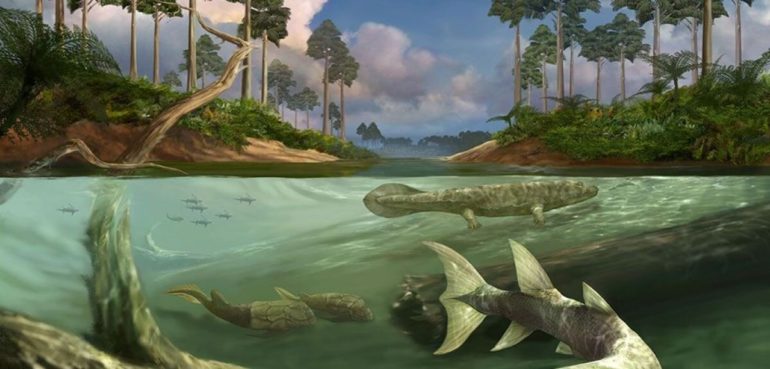Pioneering research, published in Proceedings of the Royal Society A, into ancient tides during the Late Silurian—Devonian periods (420 million years ago—380 million years ago), suggests that large tides may have been a key environmental factor in the evolution of bony fish and early tetrapods, the first vertebrate land-dwellers.
The study is a detailed development of a theory previously published in the same journal, which suggested that the Moon’s particular mass and orbital location are optimized for creating large tidal ranges and isolating tidal pools, which in turn may have been a biological impetus for the development of limbs in fish stranded between very high tides.
First detailed numerical simulations
Researchers from Bangor University and Oxford University in the UK and Uppsala University in Sweden have been the first to produce detailed numerical simulations to address the question of whether large tides occurred during this critical period. These are also the first calculations to relate tidal hydrodynamics to an evolutionary biological event.
The numerical simulations were computed using palaeogeographic reconstructions of the Earth’s continents in an established state-of-the-art numerical tidal model. The simulation results show tidal variations in excess of four meters occurring around an area known as the South China block, which is the site of the origin and diversification of the earliest bony fish group, and has produced the earliest important fossils for this group. Geological evidence also points to tidal environments being closely associated with this class of fossils.
These first-of-their-kind results stimulate the need for more detailed tidal simulations of the ancient Earth. In particular, the researchers believe that the method used in this study can be used with a variety of palaeogeographic reconstructions at other time periods, to explore the tidal influence upon the origin and diversification of other early vertebrates, and perhaps the opposite as well: what might have been the role of tides in precipitating marine extinction events?
Jupiter’s moons could be warming each other
More information:
H. M. Byrne et al. A key environmental driver of osteichthyan evolution and the fish-tetrapod transition?, Proceedings of the Royal Society A: Mathematical, Physical and Engineering Sciences (2020). DOI: 10.1098/rspa.2020.0355
Provided by
University of Oxford
Citation:
Large tides may have been a key factor in the evolution of bony fish and tetrapods (2020, October 23)
retrieved 26 October 2020
from https://phys.org/news/2020-10-large-tides-key-factor-evolution.html
This document is subject to copyright. Apart from any fair dealing for the purpose of private study or research, no
part may be reproduced without the written permission. The content is provided for information purposes only.



